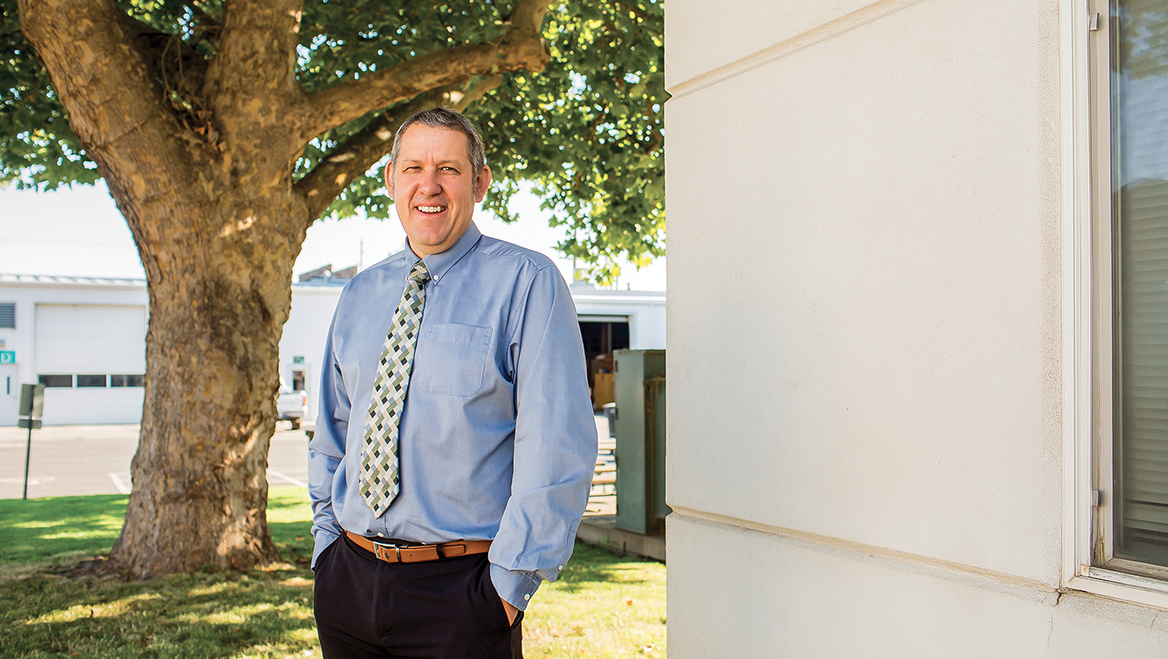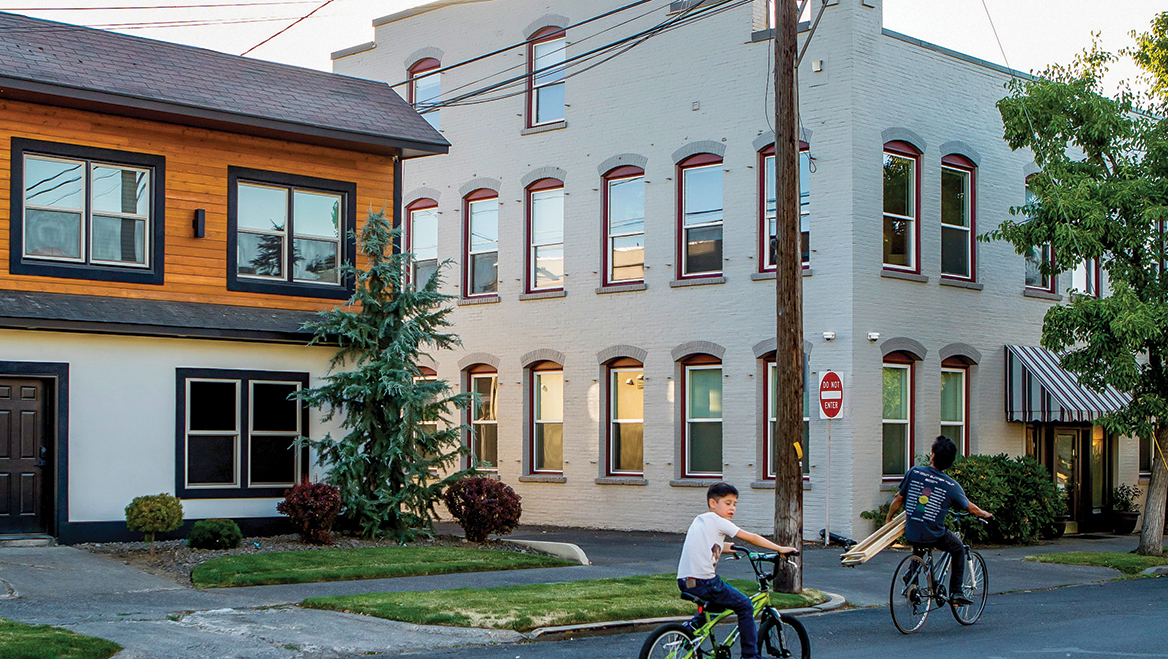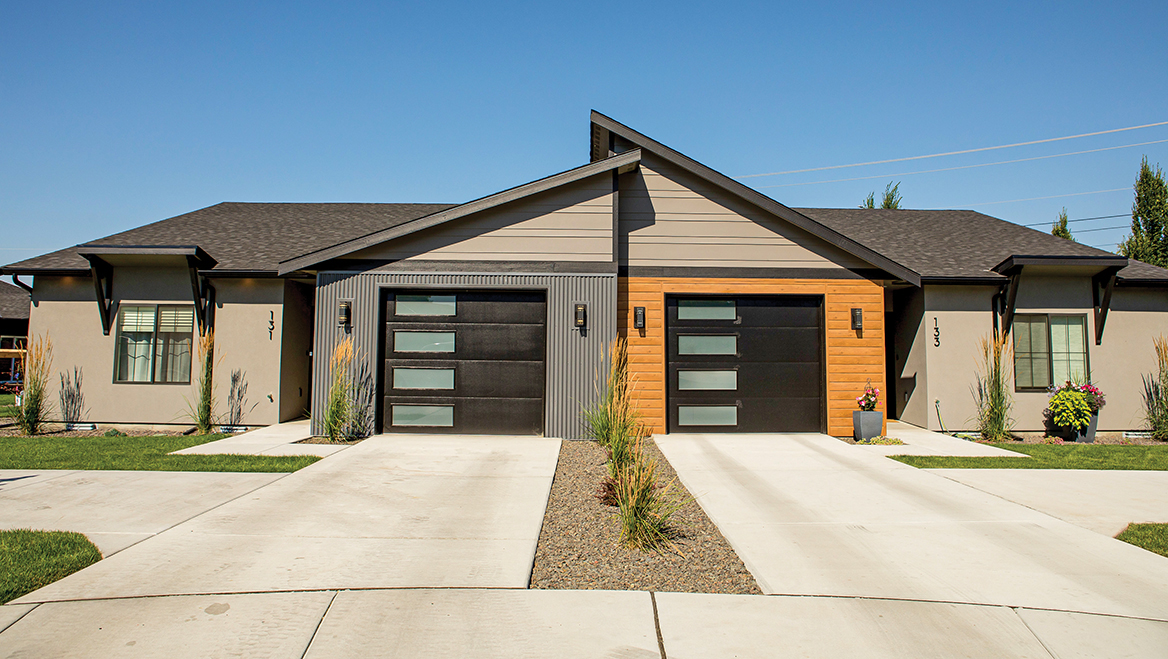Sept. 21, 2022
On a sweltering July day, Elizabeth Chamberlain, AICP, shares her vision for the future of Walla Walla, Washington, by revisiting its past.
We explore Palouse Street, the spine of the city's historic housing district. The diversity of architecture, from purple-shuttered Victorian mansions with clapboard siding to sleek Prairie Style homes with low-pitched roofs, is complemented by a cornucopia of towering trees. The branches of scarlet oaks, conifers, catalpas, and even a giant pecan tree cross overhead to cast shadows on the sidewalk.
Deputy City Manager Chamberlain conducts the tour from an air-conditioned SUV to avoid wilting in the 104-degree weather. But she doesn't recite historical facts or highlight architectural features; she points out clusters of multiple mailboxes, side staircases, and smaller cottages set between the stately homes.
Settled, built, and even subdivided before the era of zoning, Palouse and the city's other historic boulevards offer former single-family homes — including mansions — split into apartments. This housing diversity happened organically, she explains, and it has only made the street more attractive to residents.
So when allies across the planning department and the city council, including then-Development Services Director Chamberlain, began their successful bid for zoning reform in 2017, they used that messaging to help gain consensus: The city needed a lot more Palouse Streets.

Deputy City Manager Elizabeth Chamberlain. Photo by Celeste Noche.
"Everyone would like to live in these old historical neighborhoods where you just happen to see mansions across from multifamily apartments, rows of duplexes, and single-family homes," says Riley Clubb, the software developer and former city council member who helped push Walla Walla's zoning reform. He even distributed blue baseball caps sporting the phrase, "Make Housing Diverse Again."
A seventh-generation resident, he says housing diversity, affordability, and availability are the issues that will make the city stronger or weaker, depending on how they're handled right now. "Success for me personally would be if the fourteenth generation is able to live here happily if they want, or at least has the choice," he says.
In 2018, Walla Walla officially approved zoning reform that streamlines accessory dwelling unit (ADU) regulations, promotes multifamily housing, and effectively upzones the entire community. It came at a pivotal point for the city — and hundreds like it.
Growing smarter, not just larger
Tucked in a valley amid the rolling Palouse hills and striking Blue Mountains of eastern Washington, Walla Walla is, like so many urban centers its size, in a state of flux. A small but growing rural city encircled by some of the nation's richest wheatfields, orchards, and vineyards, it's also an established center of tourism and a draw for retirees and remote workers.

Downtown Walla Walla supports a culinary and arts community. Photos by Celeste Noche.

Gustavo Reyna, a Walla Wall council member, supports local zoning reform efforts.
As Gustavo Reyna describes it from a bench under City Hall's columned entrance, Walla Walla is transitioning from a classic rural town into a more complex, forward-thinking place. The walkable downtown, the community, the restaurants, the architecture, and the wine convinced the city council member and his wife to relocate from Boulder, Colorado, five years ago (he's still holding on to the bottle he bought the night he decided to move).
But outside the quaint nostalgia of Walla Walla's early 20th-century downtown (which was recently named to the National Historic Register), strips like Ninth and Isaacs Avenues boast 1970s-style subdivisions, strip malls, and sprawl, with single-family homes stretching across huge lots. Even charming, small-town life can't escape the housing and affordability challenges that plague much of the country.
The median price of a home in Walla Walla has jumped from just under $300,000 in 2019 to $489,000 today, while rent for a two-bedroom apartment increased by $300 in that same time period. Twenty-eight percent of the area's renters put half their income or more into housing, and the affordable unit count falls about 3,700 units short of where it needs to be — a big gap for a city of just about 33,000 people.
That population, predicted to hit nearly 40,000 by 2038, isn't quite skyrocketing. But steady pressure without an outlet will strain resources and push away those who can't keep up. "When you're a certain size and you do see [the population increase] just one or two percent every year, it does, as you know, add up over time," says Senior Planner Jon Maland, AICP.

Agricultural fields surround the northern part of the city, restricting growth. Photo by Celeste Noche.
With prime agricultural land encircling the town and providing a barrier to expansion, Walla Walla's planners knew the town needed to grow smarter, not just larger. They saw the next comprehensive plan update, mandated by the state's Growth Management Act, as an opportunity to encourage denser development, create more diverse neighborhoods, and even spur commerce and mixed-use development.
"It's about how we maintain the character of the city, what makes Walla Walla the great community that it is, while making sure that we grow responsibly," says Chamberlain.
To do so, Maland says, they needed to address the unnecessary complexity of the existing zoning code. During a chat in his office, he pulls out bound stacks of decades-old zoning maps and thumbs through different neighborhoods. Most streets had three different residential zoning designations, he explains, and for no apparent reason. They all ended up with the same result: four to seven single-family homes per acre.
"Same lot size and same housing product, your typical suburbia," he says.

Senior Planner Jon Maland helped simplify the local zoning code to promote housing diversity. Photo by Celeste Noche.
The answer was Neighborhood Residential (RN), a near-universal residential zoning designation that allows builders to go as dense as 75 units per acre, given that they still meet existing standards like landscaping, height, setbacks, parking, and lot coverage. Property owners can create duplexes, fourplexes, cottage homes, and even tiny homes with some relaxed parking requirements.
And then there are the ADU regulation amendments. The maximum size in Walla Walla is now 800 square feet, without limits in relation to the principal dwelling unit. Owner-occupancy requirements have been scrapped, approval is ministerial and doesn't require special permits, and ADUs can even be attached to duplexes.
The city, Chamberlain says, simply doesn't need to dictate what is done with each lot.
Planners, property owners, and even developers see the change as an excellent way to add density, and in the case of the latter, profitably build homes for different income levels. Deb Flagan, vice president of Hayden Homes, a regional builder based in Redmond, Oregon, that works in roughly 65 municipalities in the state, says her company has built about 20 homes a year in Walla Walla for decades, mainly traditional 2,000-square-foot, single-family models. In 2017, the firm realized that, based on its calculations, it couldn't meet a standard internal metric for construction: homes that a family making the median area income could purchase.
The new zoning standards, she says, "give us flexibility now to actually bring in different types of homes. Now we can build what communities are asking for and serve a very diverse population."

The maximum ADU size in Walla Walla is now 800 square feet, without limits relating to the principal dwelling unit. Photos by Celeste Noche.

Up to 75 units per acre are now permitted as long as existing standards like height, setbacks, and landscaping are followed. Here, a new duplex is under construction.
The vision slowly takes shape
Walla Walla planners saw the affordability and accessibility challenge coming as developers favored subdivisions with large lots. Other cities at the time were experimenting with zoning changes, including Minneapolis and Olympia, Washington. Melissa Shumake, AICP, a former Walla Walla city planner, came up with the RN designation after reading about a similar concept from Strong Towns, a nonprofit advocating progressive planning ideas.
"The housing problem is pretty broad," says Riley Clubb, the former council member. The city faces a growing homelessness crisis, and in 2015 built the Sleep Center, a complex of 36 small shelters. But there's also an immense and much broader issue of basic inaffordability, where very middle-class households can't afford to buy. The city's bright spots — high quality of life, vibrant downtown, and the community benefit of a small town — have become catalysts for tourism, short-term rentals, and a growing wine industry.
"When I was 15, if you used the term Walla Walla and tourism in the same sentence, you'd be laughed out of the room," says Clubb.
Walla Walla also boasts a significant young adult population, in part because of a trio of colleges, including Whitman College and Walla Walla University. Thirty percent of the population is under 35 per the 2020 census — a good demographic sign compared to many aging rural communities, but also a symbol of the failures of the housing market. Young adults wanted to stay, but affordable starter homes and available apartments were nonexistent, says Gustavo Reyna; he believes that percentage would be higher with more housing options.
To get the city on board, the planning department began conducting significant outreach in 2017, working with council members like Clubb and engaging with residents for much of 2018 at community meetings, farmers markets, and planning commission meetings. They also created a stakeholder advisory group, connecting with professionals like real estate agents, homebuilders, and representatives at Whitman College. They didn't pose yes or no questions, Maland says, but instead showed their thinking.
"We gave people examples of apartment buildings and structures in a typical residential neighborhood and examples that Walla Walla already had," he says. "We said, 'We're looking at a policy of permitting what we already have in our established neighborhoods.'" Notably, Walla Walla hasn't seen the kind of pushback that forced other cities experimenting with zoning reform, like Minneapolis, to rescind some of the more aggressive changes.

Planners shared examples of existing multifamily homes in typical residential neighborhoods to gain support for the change. This single-family home was converted into a multifamily building on South Palouse Street. Photos by Celeste Noche.

This ADU tucked behind a single-family home was built forthe owner's mother after she sold her Victorian home across town.

An older apartment next to a recently constructed multiunit building on Birch Street.
Results since the passage of the plan in 2018 have been limited due to the pandemic. So far, the numbers aren't showing a dramatic change. In 2018, the city issued permits for 121 single-family homes and four ADUs; this year, through August 19, the city issued permits for 29 single-family homes, 14 duplexes, and a single ADU.
But developers have begun investing in new types of projects, including apartment complexes and conversions of motels into affordable housing. Slowly, case studies burgeoning around town suggest the planning department's vision is taking shape.
Just south of Walla Walla High School, Herbert Estates by StoneCrest Builders contains a mix of one- and two-story, slate-roofed duplexes, with 18 units covering 11 standard lots. The mixture of home types has created "a great place for young families to start," says Elizabeth Chamberlain. "We're trying to show people that this kind of building still fits," she adds.
At 131 and 133 Sonoma Place, crisscrossing roof lines offer a bit of mid-century modern style to a twin townhouse development on the city's northeast side that showcases the potential of infill projects under the new standards. They're not necessarily adding to the affordable stock, as one of the sleekly appointed three-bedroom units sold for $447,000, but it does show how independent builders can take advantage of the new plan's potential.

Townhomes on Sonoma Place showcase the potential of infill projects under the new standards. Photo by Celeste Noche.
Another forthcoming project — the Harvey Ranch development by Hayden Homes on the city's northern edge — just broke ground, with basics like water pipes and roads taking shape. Chamberlain sees so much more happening there: denser, more walkable streets, homes hitting the $350,000 range (which will impact the affordability deficit), enough residents to support more nearby commerce and mixed-use development, and a virtuous cycle of density and commercial opportunities that creates a core of activity on what is now the city's edge.
Meanwhile, planners and city council members haven't stopped advocating for new policies that promote housing in Walla Walla. Reyna hopes to expand the city's historic preservation funding to restore older homes and commercial spaces and preserve classic architecture. The city is also looking into expanding the state multifamily tax incentive, which municipalities have some leeway in dispensing, to help leverage existing public lands to add more apartments. Clubb has even started work on a community land-trust model, finalizing nonprofit status and seeking to begin fundraising for new projects.
As his campaign hats argue, it's time to embrace housing diversity.
"Is this really what we want, the cookie-cutter model, where everything looks the same?" asks Clubb. "We're not all the exact same, right? Why would we expect our housing and neighborhoods to look exactly the same?"




